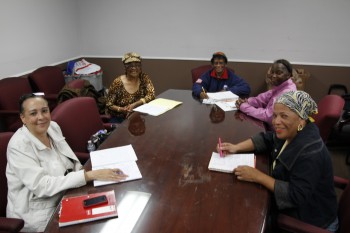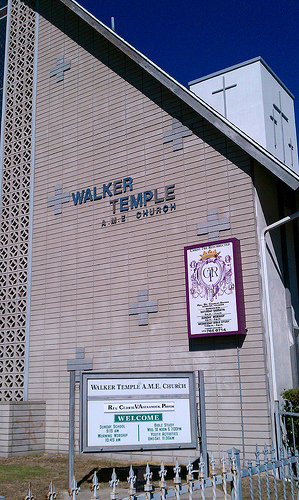
The weekly meeting of The Ladies of the African American Cultural Awareness Ministry of Holy Name of Jesus Catholic Church. Clockwise from left: Monica Lewis, Eva Gallegos, Cathy Brown, Dolores Ricks and April Stone.
“En el nombre del padre del hijo y del espiritu santo,” echoes the congregation gathered at the Holy Name of Jesus Catholic Church. In unison, they touch their foreheads, chest and arms in the sign of the cross.
Banda music celebrating Jesus’ ascension into heaven soon fills the large 90-year-old sanctuary adorned with a stained glass window and statues of Black saints.
The music begins to fade upon entering a meeting room next to the main church, located at West 31st Street and Jefferson Boulevard. Inside, members of the African-American Cultural Awareness Ministry begin their weekly meeting.
“We want to help maintain an African-American Catholic identity, not to be divisive, but to worship in a style we’re accustomed to. — in gospel, music and liturgy and bring them to the table,” said Dolores Ricks, a devoted parishioner of 15 years.
“There are two churches in one parish,” said Ricks. “We can’t fight the cultural barrier.”
Within the last decade, the once predominately Black area of South Los Angeles is now two-thirds Hispanic, according to a report by USC, prepared for the Community Coalition.
One technique to help integrate the Black church with the surrounding Hispanic community is offering bilingual services. The church has offered bilingual services but phased it out due to low attendance.
Yet in most cases, as happens at Holy Name of Jesus, Hispanics worship with Hispanics and Blacks worship with Blacks.
“People tend to worship with people who look like them, walk like them or talk like them. It’s just in our nature to do that,” said Reverend Najuma Smith Pollard, program manager at the Cecil Murray Center for Religion & Civic Culture.
Less than five miles away, Walker Temple AME church is having more success with its own bilingual worship service.
 “We want people to know that our God is a God for everyone. He transcends color,” said Pastor Rosalynn Kyle Brookins, senior pastor at Walker Temple.
“We want people to know that our God is a God for everyone. He transcends color,” said Pastor Rosalynn Kyle Brookins, senior pastor at Walker Temple.
Brookins, who came to Walker Temple in 2004, greets visitors to the church off Adams Boulevard and Trinity Street, with the phrase, “Woman of God. How are you?” or “Man of God. How can I help you?”
Iglesia Cristiana Vencedores Por La Fe has been renting out the church for its Spanish-speaking congregation for over 20 years, but never interacted with the members of Walker Temple until Brookins arrived.
Even the church’s newsletter has changed. Instead of having English in the front and flipping the newsletter over for Spanish in the back, Brookins intentionally writes announcements together on one page in a process she describes as “a wholeness between divided cultures.”
“It’s been a positive experience because we have never done that before. You feel there’s no barrier,” said Marjorie Soto, whose uncle is a pastor at Iglesia Cristiana.
However, the language barrier still drives a wedge between worshippers who feel uncomfortable in a bilingual setting.
Soto said it doesn’t bother most of the children who grew up speaking English, but those who only understand Spanish hesitate to attend because they’re unsure of what’s being said.
Soto said the bilingual service features both English and Spanish choirs and an interpreter, who accompanies her uncle, Pastor Edgardo Soto, or Brookins as they preach.
Working with an interpreter requires its own special skill, as each pastor must keep their sermons short and slow enough for the interpreter to catch-up.
Still, despite the effort to join congregations, Pastor Brookins admits she has lost members who did not understand the need to cater to the Hispanic community.
“We talk inclusiveness and togetherness but [sometimes] no one wants to go out on that limb. Racism is alive and well, and to play like it is or isn’t is blind,” said Brookins.
Keeping the Black tradition alive
Many historically Black churches in South L.A. were built to serve the needs of the Black community, whether it was serving as a shelter during the 1992 Los Angeles Riots or a place to rally for civil rights.
The migration of Blacks out of Los Angeles meant leaving behind a cultural and political cornerstone of their community.
And this has been one of the biggest challenges facing the Black church as it handles the changing economic and community demographic of South LA.
“What’s happening with our churches is not so much people are leaving the churches, it’s just no new people are coming.” said Pollard of the Cecil Murray Center.
Churches with a long history in the community are now serving their members regionally, as established churches like Holman United Methodist Church on Adams and 4th Street serves a growing population of commuters, offspring of long-time Holman members who have moved to areas like the San Fernando Valley, the Inland Empire, Fontana and Carson.
“It has forced us to re-envision our ministry.” Rev. Kelvin Sauls, senior pastor at Holman United Methodist, said. This includes utilizing Facebook bible study groups or broadcasting their worship services on KLJH 102.3 FM.
“South L.A. is a microcosm of what’s happening in California for established Black churches.” Sauls, who is also director of new ministries for the California Pacific Conference of The United Methodist Church, said about serving older and commuter demographics.
But as Sauls wraps up his first year as senior pastor at Holman, he wants the church to continue serving both the local and regional community.
“We are envisioning a multi-lingual church, not Hispanic, and I say that intentionally, because Holman is already a multi-cultural congregation. We have members all over the world…Our members from Belize and Panama already speak Spanish.”
Though the congregation does not have a large Hispanic presence, the church still serves the largely Hispanic community surrounding the church.
It started a Zumba class for the community and maintains close contact with City Councilman Herb Wesson, the local neighborhood councils and the Crenshaw Chamber of Commerce, to address issues of education and homelessness for all who live near West Adams.
“The church was a hub for community outreach. When you think of civil rights, churches in L.A. were hubs of places to combat injustice in many of its forms,” said Donna Richardson, Holman’s church historian. “We do God’s work.”















Speak Your Mind